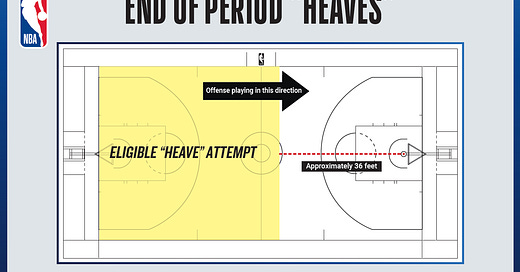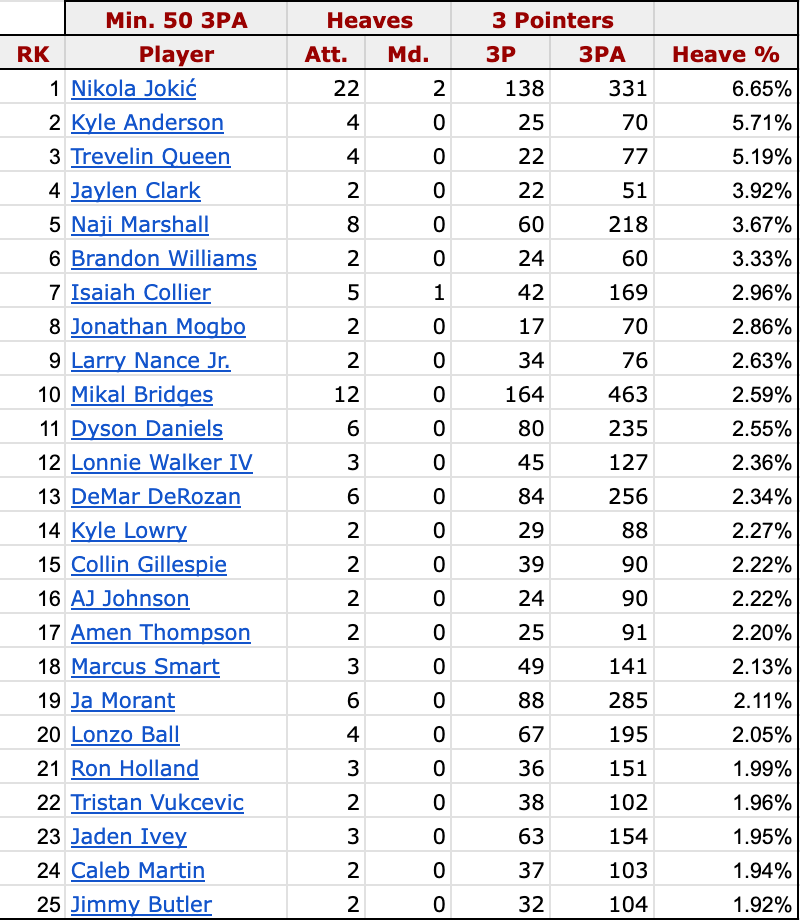Heave Heroes: The Winners of the NBA’s New Rule Change
These are the heroes who didn’t need a rule change to throw caution, and the ball to the wind
What should have been one of the most exciting plays in the NBA became a graveyard of half-hearted, cowardly tosses. These ruses of self-sacrifice suggested intent but were, in fact, performance art of the most undignified order, designed to feign the lowest muster of effort, all in a scheme to preserve a false efficiency. I’m, of course, talking about heaves.
The NBA, up until now, has never cared to differentiate a heave from any other shot, and why should they? Sure, heaves are desperate 3-point attempts with little chance of success, but they’re still a chance to score points as a quarter or game expires. Unfortunately, players, rightly motivated by factors outside of simply winning games, such as remaining employed, have decided that heaves were simply not worth it. Why hurt your 3-point and field goal percentage on the minute chance you could help your team win a game? If you’re a marginal player, two or three percentage points as a 3-point shooter can be the difference between a contract and millions of dollars, and no one is going to remember that you missed that 75-foot heave in January at the end of the first quarter against the Wizards while your team led by four.
Fortunately, the NBA has come in to rectify the situation. Heaves, shots taken approximately 36 feet from the basket and with three or fewer seconds left in the game, quarter, or shot clock, will not be counted as a shot unless the attempt is successful. What was once a suicide mission will now be free real estate, as the kids said, like ten to fifteen years ago. And with this rule change, the dastardly performative heaves that intentionally left the shooter’s hand but a half-second after the clock’s expiration will die the swift death they always deserved.
While such a scoring change was long overdue, and should lead to an explosion of heaves, we should reward, applaud, and venerate the brave souls who never cared for superficial stats and heaved for the good of the team. Thankfully, Basketball Reference tracks heaves, and while their definition and tracking might not align exactly with the NBA’s going forward, I trust their definition is close enough to conduct a meaningful analysis.
Last season, 521 heaves were attempted, leading to 12 made shots, and good for a 2.3% field goal percentage. Conversely, 92,453 3-pointers were attempted, with 33,304 makes leading to a 36.02% field goal percentage. Due to heaves, NBA players were docked a minuscule 0.21% of 3-point percentage, but clearly, the value proposition many around the league made was that heaves were not worth the trouble. However, not all men are cowards.
It should come as no surprise that Nikola Jokic, the patron saint of squeezing every last competitive advantage out of the game, led the league with 22 heave attempts and two makes. His next closest competitors were Mikal Bridges and Anthony Edwards, with 12 and 10 attempts, but their valiant heroics left them empty-handed. Jokic, on his own, accounted for 4.2% of all heave attempts and 16.67% of all makes, and his Heave%, the percentage of his 3-point attempts that were heaves, came in at 6.65%, the highest among players to attempt over 50 3-point attempts.
Instead of waxing poetically about Nikola Jokic’s insatiable desire to hit insane shots, let’s take a look at a few heave charts to highlight the other brave souls in the NBA’s version of the Suicide Squad.
Top-25 in Heave Attempts
Top-25 in Heave%
Before we move on to who would have benefited most from the NBA’s new rule change, I want to highlight Ausar Thompson and Steven Adams. Thompson only attempted 49 3-point attempts, which saw him miss the cut-off by a single attempt, but he still managed to attempt four heaves. His 8.16% heave% was the highest among players who attempted more than 20 3-point attempts. Meanwhile, Steven Adams only attempted two heaves, but those heaves were his only 3-point attempts on the season, which left him as the only player with a heave% of 100%.
As mentioned earlier, the NBA, starting next season, won’t count a missed heave as a missed 3-pointer for the individual player, but it will count as a missed shot for the team. This is similar to how shots on fouls are charted and the distinction between a team and individual turnover. These are the players who would have seen their 3-point shooting efficiency improve the most if the league had instituted this scoring change last season.
Top-30 3-Point% Gainers
There’s an argument to be made that Jokic’s MVP candidacy was hurt due to his penchant for hoisting heaves. He lost nearly three percentage points on his 3-point shooting, while Shai Gilgeous-Alexander only attempted one all season. I’m dubious that Jokic going from 41% to 44% on threes would have won him the award, but it probably would have swayed a few voters his way. On another note, Mikal Bridges’ 3-point shot was much decried by Knicks fans, but when you factor in his 12 heaves, his 36.4% shooting on 7.6 3-point attempts per 100 possessions represents a pretty standard mixture of volume and efficiency from the wing.
And to cap it all off, here is the team heaves leaderboard, with the caveat that apparently the players who got traded last season were quite a heave-happy bunch.
For any inquiries about work, discussion, and the like, you can email me at nevin.l.brown@gmail.com.









Great article, love this!! True hoop heroes indeed
Typically, I don't like stats that ignore what actually happened in favor of what's "fair" based on subjective measures--in this case, 36 feet is a "heave," but 35 feet is not. (A good example of this is using ERA in baseball instead of RA9.) That said, I think this is, overall, a good change for the reasons you stated.